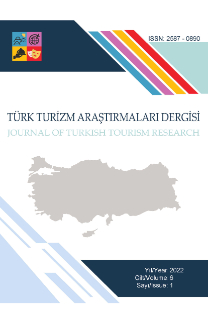Turizmde Maneviyat Arayış Aracı Olarak Yoga
Son yıllarda dünya üzerinde artan nüfus artışıyla birlikte gelişen; gürültü, trafik, iş sıkıntıları, hastalık gibi kişiyi direkt veya dolaylı olarak etkileyen problemlerin ortaya çıkması kişileri bir arayışa itmektedir. İnsanlar bu problemlerden uzaklaşmak ve kendini bulmak amacıyla turizm adı altında birçok alt pazarı denemeye ve beraberinde yeni arayışlara girmeye başlamıştır. Bu çalışma; yoga turizmini maneviyat arayışı olarak benimseyen kişiler üzerinde yapılan nitel olay incelemesini sunmaktadır. Çalışmanın amacı; kişilerin yoga turizmi ile hangi amaçlarla inzivaya çekildiklerini saptayabilmek ve bu turizmi kullanan kişilerin geri dönüşümlerini mülakatlar aracılığıyla ve katılımcıların katkılarıyla incelemektir. Bu çalışmada insanların neden inziva alanlarına seyahat ettiklerini incelemek amacıyla yapılandırılmış görüşme tekniği kullanılmıştır. Daha önce inziva amacıyla yoga seyahati yapmış kişiler İstanbul genelinde saptanıp bunlar arasından 30 katılımcıya 17 soru yöneltilerek güvenilir bilgiler elde edilmeye çalışılmıştır. Veri toplama işlemi veri doygunluğuna ulaşıldığında bitirilmiş olup çalışma bulgularına göre yoga turistlerinin özellikle maneviyat arayışı olarak gerçekleştirdikleri seyahatlerinden sonra; bu kişilerde olumlu psikolojik etkiler gözle görülür bir şekilde verilen cevaplar aracılığıyla saptanmıştır
Yoga as a Spiritual Awakening Instrument in Tourism
With the increasing population growth in the world in recent years; problems such as noise, traffic, work problems, illness, etc. directly or indirectly affect the emergence of people. People started to try many sub markets under the name of tourism in order to get away from these problems and find themselves. This work; It presents a qualitative case study on people who adopt yoga tourism as a search for spirituality. Purpose of the study; The purpose of this course is to determine the reasons of the people's seclusion with yoga tourism and the recycling of the people using this tourism through the interviews and the contributions of the participants. In this study, structured interview technique was used to investigate why people travel to retreats. Previously, people who had a yoga trip for the purpose of hermitage were identified throughout Istanbul and among these, 17 questions were asked to 30 participants and reliable information was obtained. Data collection was completed after data saturation was reached and after the travels of yoga tourists as a search for spirituality according to the study findings; positive psychological effects in these individuals were determined by the answers given in a visible manner.
___
- Aggarwal, A. K., Guglani, M., and Goel, K. (2008). Spiritual and Yoga Tourism: A Case Study on Experience of Foreign Tourists Visiting Rishikesh, India. Conference on Tourism in India – Challenges Ahead, Part XI: (457-464).
- Dünya Turizm Örgütü, (1985). The Role of Recreation Management in The Development of Active Holidays and Special Interest Tourism and Consequent Enrichment of The Holiday Experience. Madrid: World Tourism Organization.
- Hall, C. M. and Weiler, B. (1992). What's Special About Special Interest Tourism? London: Belhaven Press, 1-14. http://store.hartman-group.com/content/health-and-wellness-2015-overview.pdf> [Erişim Tarihi: 10.01.2019].
- https://www.yogaalliance.org/Portals/0/2016%20Yoga%20in%20America%20Study%20RESUL TS.pdf> [Erişim Tarihi: 07.12.2018].
- Iyengar, B. K. S. (2016). Yoga ve Siz (2. Baskı). İstanbul: Okyanus Yayıncılık.
- Koncul, N. (2012). Wellness: A New Mode of Tourism. Economic Research-Ekonomska Istraživanja, 25(2), 525-534.
- Kumar, P. (2015). Yoga Tourism–A Unique Feather in The Cap of Indian Tourism. Advances in Economics and Business Management (AEBM), 2 (9):922
- Liberman, K. (2004). Yoga Tourism in India. Yoga Life, 7(35), 23-32.
- Lıdell, L. (1983). The Sivananda Companion to Yoga, Simon & Schuster Inc.: New York.
- Lehto, X., Brown, S. and Morrison, A. (2006). Yoga Tourism as a Niche Within the Wellness Tourism Market, Tourist Recreation Research, 31(1), 25-35.
- Maddox, C. B. (2014). Studying at The Source: Ashtanga Yoga Tourism and The Search for Authenticity in Mysore, India. Journal of Tourism and Cultural Change, 13(4), 330-343.
- Nichter, M. (2013). The Social Life of Yoga: Exploring Transcultural Flows in India. In Yoga Traveling, Germany: Springer. 201-224.
- Nimrod, G. (2007). Retirees’ Leisure: Activities, Benefits, and Their Contribution to Life Satisfaction. Leisure Studies, 26(1): 65–80.
- Patanjali, (2012). Yoga Sutra İçsel Özgürlüğün Yolu, (1. Basım), İstanbul:Arıtan Yayınevi.
- Patterson, I., Getz, D., and Gubb, K. (2016). The Social World and Event Travel Career of The Serious Yoga Devotee. Leisure Studies, 35(3), 296–313.
- Saraswati, S. J. (2001). Yoga (3. Baskı). İstanbul: Okyanus Yayıncılık.
- Sarı Y. ve Şenel E. (2018). Bir Ekorekreasyon Faaliyeti Olarak Yoga Turizmi Üzerine Bir İnceleme. International Rural Tourism and Development Journal Uluslararası Kırsal Turizm ve Kalkınma Dergisi, 2 (2): 20-23
- Sharpley, R. and Sundaram, P. (2005). Tourism: A Sacred Journey the Case of Ashram Tourism, India. International Journal of Tourism Research, 7:161–171.
- Smith, M. and Kelly, C. (2006). Holistic Tourism: Journeys of The Self, Tourism Recreation Research, 31(1): 15-24.
- Smith, M. (2003). Holistic Holidays: Tourism and The Reconciliation of Body, Mind and Spirit. Tourism Recreation Research, 28(1): 103-108.
- Verschuren, F. (2004). Spa Health and Wellness Tourism: A New Product Portfolio at the Canadian Tourism Commission. Ottawa: Canadian Tourism Commission
- Vivekananda, S. (2014). Patancali‟nin Yoga Bilimi, Yoga Sutraları. (2. Baskı), İstanbul: Purnam Yayınları.
- Xinran, Y.L., Brown, S., Chen, Y. and Morrison, M.A. (2006). Yoga Tourism as a Niche within The Wellness Tourism Market. Tourism Recreation Research, 31(1): 25-35
- ISSN: 2587-0890
- Yayın Aralığı: Yılda 4 Sayı
- Başlangıç: 2017
- Yayıncı: Prof. Dr. Yüksel ÖZTÜRK
Sayıdaki Diğer Makaleler
Mağara Turizminin Akçakoca Turizmine Etkileri: Fakıllı Mağarası Örneği
Turistik Destinasyonlarda Talep Yönetimi ve Demarketing Uygulamaları
Nilüfer VATANSEVER TOYLAN, Nihal YILMAZ
Kadın ve Turizm Konulu Lisansüstü Tezlerin Bibliyometrik Analizi
Dilara Bahtiyar SARI, ZEKI AKINCI
Tekirdağ Mutfak Kültürü Üzerine Bir Değerlendirme
Enver ŞİMŞEK, Özgür KIZILDEMİR
Amasya İlindeki İbadethanelerin İnanç Turizmi Potansiyeli Açısından Değerlendirilmesi
Aşçıların Tükenmişlik Düzeylerinin Belirlenmesine Yönelik Kars İlinde Bir Araştırma
